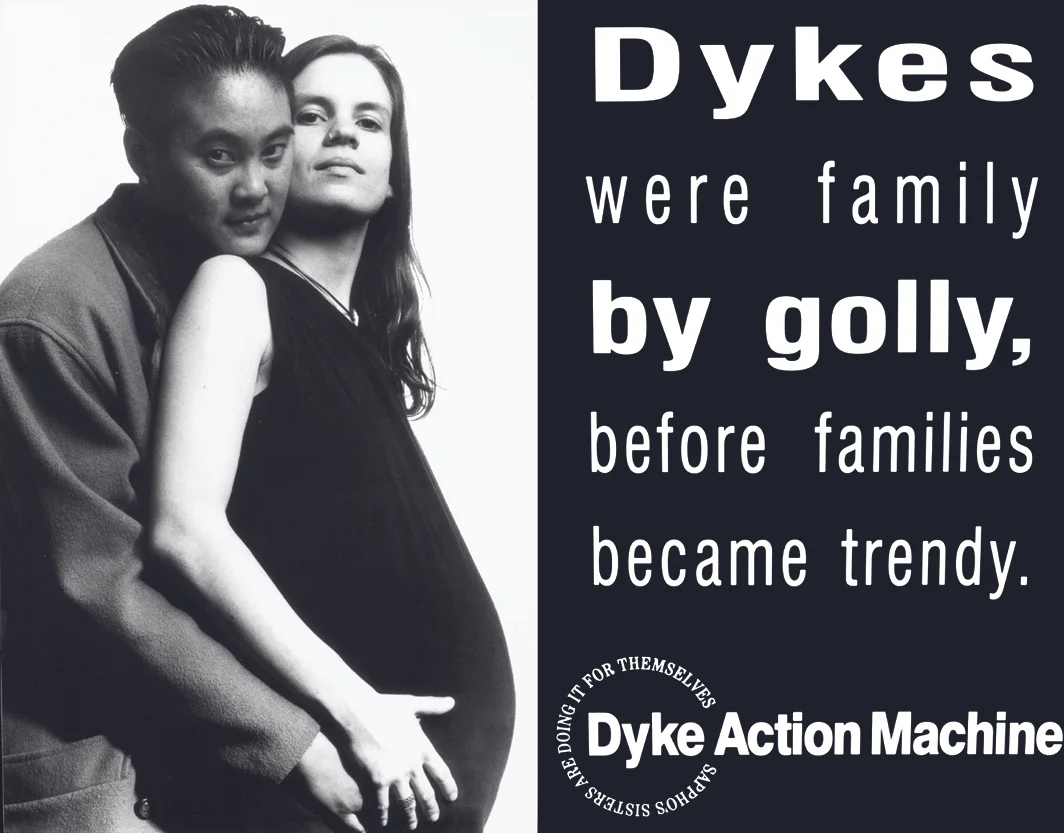Family Circle (1992) | Dyke Action Machine
Dyke Action Machine! Family Circle, 1992. Courtesy of the artists
Dyke Action Machine!, a two-person public art project founded in 1991 by artist Carrie Moyer and photographer Sue Schaffner, has had a pronounced visual impact on New York City-based artistic activism over the last three decades. DAM! was one of the first queer interventionist art projects to explicitly address the lived experience of American lesbians. Between 1991 and 2004 DAM!’s wheat-pasted poster campaigns appeared regularly throughout the streets of New York City. Dyke Action Machine! has participated in over 40 exhibitions throughout the US and Europe and, most recently, was included in the ground-breaking exhibition “Agitprop!” at the Brooklyn Museum in 2015.
Throughout the 1990s Dyke Action Machine! campaigns presented a hybrid form of public address where civic issues were packaged to fit seamlessly into the commercialized streetscape. The projects inserted lesbian images into recognizably mainstream contexts, revealing the relationship between visual representation and perceived consumer presence. DAM! performed the role of the advertiser, promising the lesbian viewer all the things she’d been denied by the mainstream: power, inclusion, and the public recognition of identity.
A typical DAM! campaign was comprised of 5,000 posters wheat-pasted over the course of one month. Neighborhoods were targeted for both the volume and diversity of pedestrian traffic as well as their long histories as sites for graphic intervention and public discourse. As corporations and activists battled for the ever-dwindling public space in New York City throughout the 1990s, DAM! turned to other modes of propaganda (lightboxes, catalogs, matchbooks, buttons and stickers to name but a few) and distribution (the US Postal Service, the Internet and by hand).
DAM’s second project, Family Circle/Lesbian Family Values (1992), appropriated Family Circle Magazine’s ad campaign that featured hip, tattoo-covered fathers as a means of “freshening up” their brand. DAM!’s six-poster project depicted the fluid, chosen configurations of lesbian families in a direct challenge to the reactionary “Family Values” message deployed by right-wing ideologues as well as the mainstream media. Long before the triumphalist push for gay dads and legalized same-sex marriage, DAM! was questioning heteronormative mimicry as a model of acceptance.
Nearly fifteen years later, DAM! Incorporated (2008) took notice of how lesbians had been both absorbed and fetishized as they have entered the mediated consciousness. Unlike earlier projects that used iconic graphic design or up-to-the-minute advertising as their template, DAM Incorporated was based on the annual report, the most bare-bones yet essential form of corporate communication. In it, lesbianism itself has been converted into a viable and, more importantly, valuable commodity based on public perceptions and projections. DAM Inc. is a hilarious and indispensable guide to selling out.




